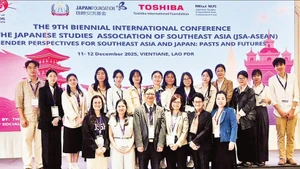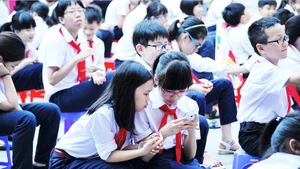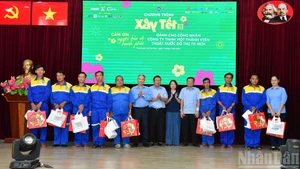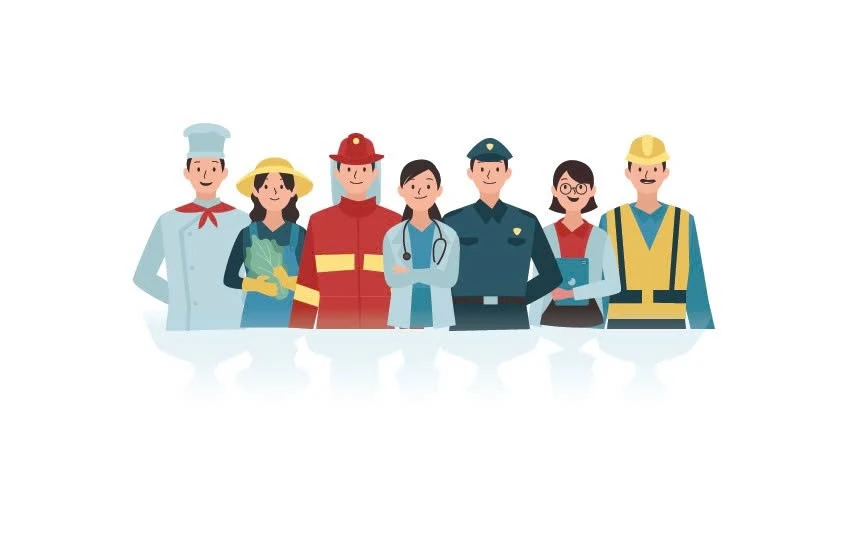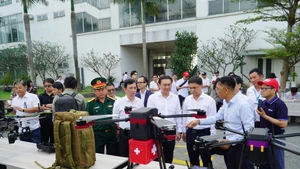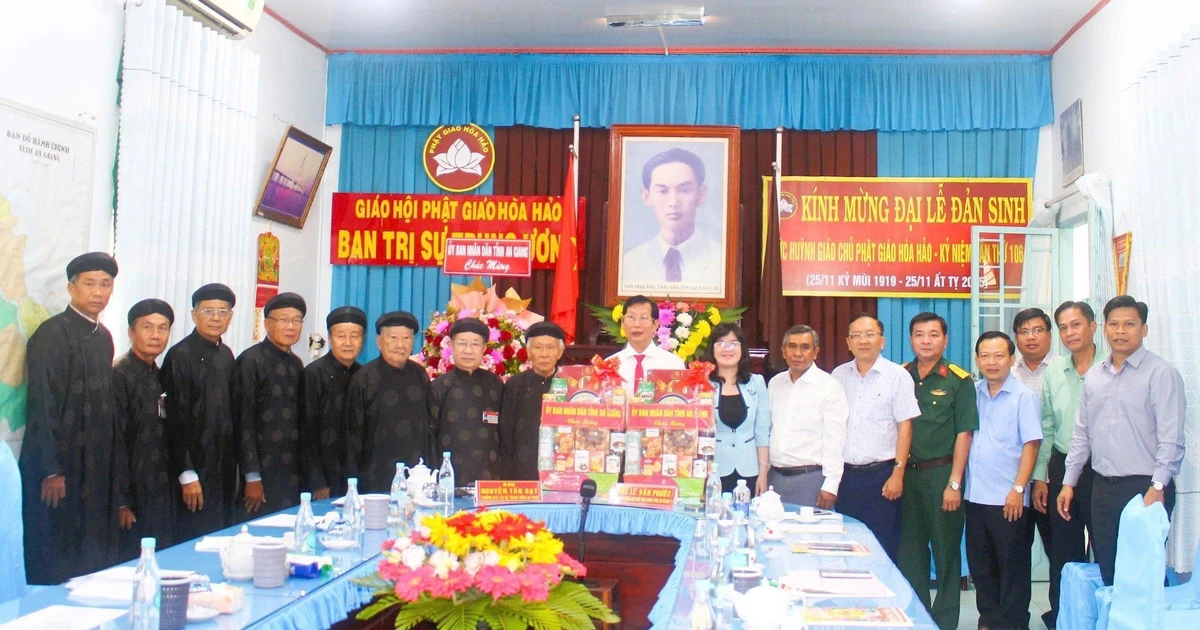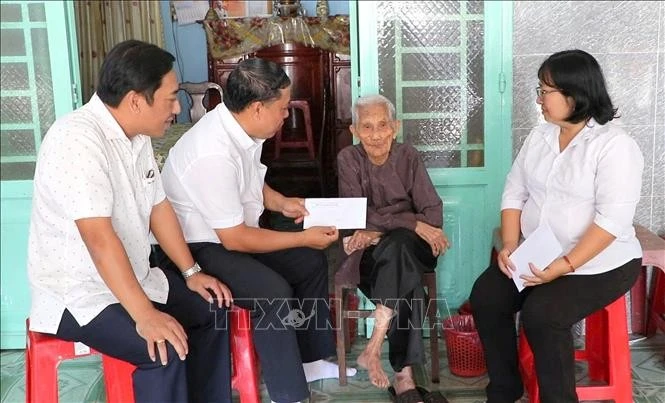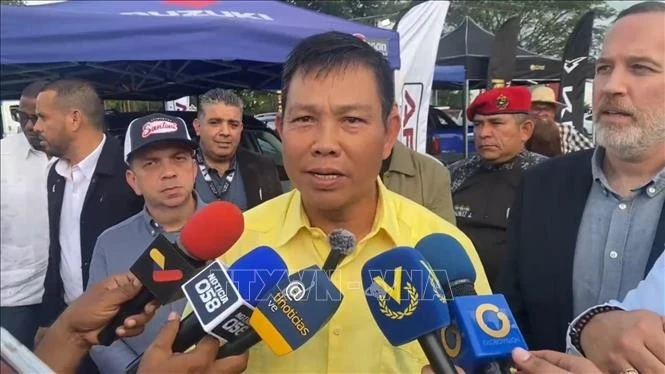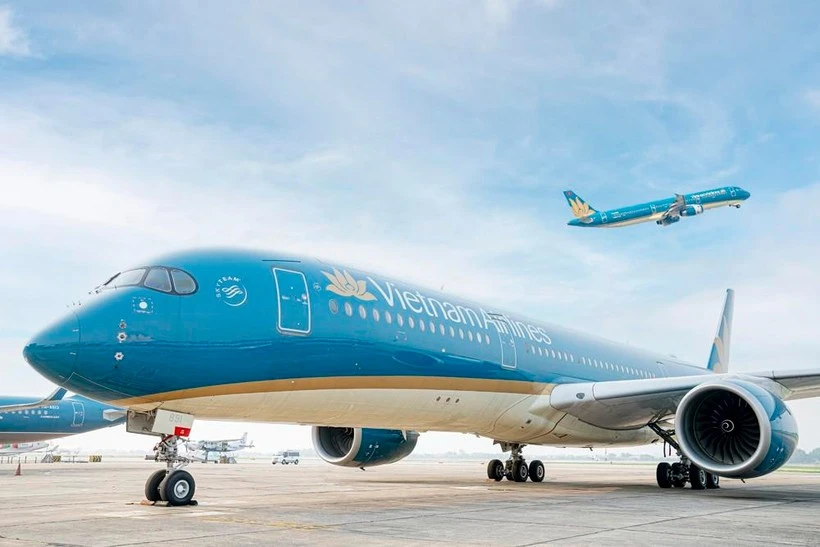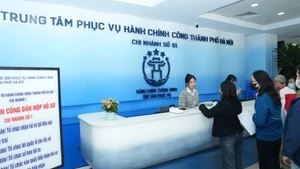These smart farming models create a closed-loop rice cultivation process that includes input supply, technical solutions, emission monitoring, and measurement and reporting methods.
Dual benefits
Implementing the plan of sustainable development for 1 million hectares of high-quality, low-emission rice fields linked to green growth in the Mekong Delta by 2030, several regions in the region have launched the “Smart wet-dry rice cultivation” model with environmental monitoring units assessing carbon emissions. Farmers use the Ecocycle process by BSB and Net Zero Carbon companies, following AWD standards, reducing the use of pesticides by about 30% and chemical fertilisers by around 10%, which leads to lower emissions and improved health for growers.
The entire process is monitored by the US-based Spiro Carbon Company's satellite technology. In Hau Giang Province, farmers in Truong Long Tay Commune, Chau Thanh A District, have implemented this model on over 18 hectares, utilising nano silica from rice husks and Cherry micro-fertiliser, resulting in healthier plants and better root development. The process includes 47 days of wet and 53 days of dry field maintenance, with strict water management practices.
This approach has reduced carbon emissions by 3.5-4 tonnes per hectare per season. The rice produced is cleaner and greener, with increased yield and improved health for farmers. La Van Hanh, a farmer in Truong Long Tay Commune, expressed his satisfaction: “Previously, we only used chemical fertilisers. Now, by reducing chemical fertilisers and using organic fertilisers, we have lowered costs while contributing to environmental protection.”
The Tan Long Cooperative in Tan Long Hamlet, Vinh Tuong Commune, Vi Thuy District has implemented this model for the summer-autumn rice crop using the OM 18 variety, covering an area of 4.2 hectares for comparison with a 1-hectare control plot. After more than three months, the traditional farming method on the control plot yielded just under 6 tonnes per hectare, with an investment cost of over 24.2 million VND per hectare and profit of nearly 20 million VND per hectare. In contrast, the smart farming model achieved a yield of nearly 8 tonnes per hectare, with an investment cost of approximately 22 million VND per hectare and profit of over 36 million VND per hectare. In addition to increasing yield and reducing investment costs, the smart model also reduced the amount of rice seed used from 120 kg per hectare in the control plot to 80 kg per hectare in the smart model.
In Can Tho City, after more than three months of cultivating rice using the low-emission farming method, the pilot rice field of the Tien Thuan Cooperative in Thanh An Commune, Vinh Thanh District, has achieved promising results. The amount of rice seed used was reduced from 140 kg per hectare to 60 kg per hectare, the number of fertiliser applications was reduced to two per season, chemical fertiliser use was decreased by at least 20%, and there was a significant reduction in irrigation water, pest risks, lodging, and post-harvest losses.
As a result, farmers saved about 1.9 million VND per hectare, with rice yields reaching 6.3-6.5 tonnes per hectare. In comparison, traditional methods of broadcasting and drilling without incorporating fertiliser yielded only 5.8-6.1 tonnes per hectare. Economically, the net profit from the rice cultivated under the project increased by 1.3-6.2 million VND per hectare. The field also reduced CO2 emissions by 2-6 tonnes per hectare compared to the control plot. Nguyen Cao Khai, Director of the Tien Thuan Cooperative, noted that under this model, farmers no longer burn straw. Instead, they either sell it or plough it into the field to create organic fertiliser, reducing the need for fertilisation in the next season.
The key benefit of implementing the project is that farmers can reduce input costs, increase selling prices, and gain additional income from selling carbon credits. Nguyen Van Thich, Director of the Tan Long Cooperative, expressed his happiness: “The cooperative is currently cultivating a 5-hectare area. The farmers are very excited because, in the past, they could only sell rice, but now they can also sell carbon credit reports. Therefore, in the future, we plan to expand even further.”
Joining hands to support farmers
The project for sustainable development of 1 million hectares of high-quality and low-emission rice and green growth in the Mekong Delta by 2030 is divided into two phases, with a total area of approximately 1 million hectares dedicated to rice cultivation by 2030. The implementation began with about 180,000 hectares in the 2023-2024 winter-spring season. One of the project's key goals is to ensure that farmers' profits reach over 40% by 2025 and over 50% by 2030.
The project aims to establish large, stable, and long-term commodity supply zones, facilitate the reorganisation of rice production in the region in a modern direction, and meet multiple objectives. These objectives include enhancing the added value of the rice chain and farmers' incomes, ensuring food security, achieving high efficiency in processing and export, building a greenhouse gas emission-reducing rice brand in line with government commitments, and adapting to climate change. The active participation of businesses and cooperatives will contribute to the rapid and effective implementation of the project.
Tran Tan Thanh, a representative from Binh Dien Fertiliser Company, said that farmers participating in the smart rice farming model will receive support from the company regarding fertilisation processes and techniques, covering 50% of the fertiliser costs, with the remaining 50% to be borne by the farmers according to Binh Dien's process. During the model's trial phase, BSB Nanotech Co., Ltd. supported 100% of the nano silica and Cherry micro-nutrient fertilisers and sent personnel to remind farmers of the proper timing for fertilisation and pesticide application at different growth stages of the rice. Net Zero Carbon Co., Ltd. has also collaborated closely with farmers throughout the smart rice farming process.
General Director Tran Minh Tien stated that from the beginning to the end of the project, the company has been providing satellite systems for monitoring, tracking, and photographing. At the end of the season, the satellites will analyse and evaluate how many tonnes of carbon emissions were reduced from this rice field. After receiving reports from Spiro Carbon Company, they will proceed to buy back the carbon credits from the farmers. Pham Minh Cuong, Project Manager at Net Zero Carbon, added that the company ensures that participating farmers will incur no additional costs while saving approximately 10% on investment costs, with no reduction in rice yield compared to the local average.
After the Sustainable Agriculture Transformation Project in Vietnam (VnSAT), funded by the World Bank (WB) and implemented in 13 provinces nationwide from 2015 to 2022, farmers have benefited from substantial investments in infrastructure such as transportation, irrigation, storage facilities, and capacity building, as well as ecological conservation on the fields. The project has not only delivered economic benefits but also had positive impacts on the environment and society.
The VnSAT project has helped reduce greenhouse gas emissions in rice production in Hau Giang Province by over 176,000 tonnes. Can Tho has used the results of the VnSAT project as a foundation to implement the project for the sustainable development of 1 million hectares of high-quality and low-emission rice and green growth in the Mekong Delta by 2030. To date, the areas involved in the VnSAT project in the city have focused on high-quality and specialty rice varieties, nearly 100% of which are premium cultivars.
Vice Chairman of the Can Tho City People's Committee Nguyen Ngoc He stated that to effectively implement the project, Can Tho will focus on consolidating and maintaining effective production activities over approximately 38,000 hectares with 25 participating communes and support the development of 34 cooperatives during the 2024-2025 period. From 2026 to 2030, the focus will shift to investing in key areas to reach 50,000 hectares as planned. The city will also dredge canals, build additional electric pumping stations, construct bridges, and expand rural roads to support the technical infrastructure of the project.
Minister of Agriculture and Rural Development Le Minh Hoan emphasised that the agricultural sector needs to leverage all available resources to quickly realise the project's effectiveness in each locality. At the same time, it should enhance cooperation, linkage, and standardisation of all rice farming processes. Businesses and farmers need to strictly follow these processes to reduce costs, lower carbon emissions, and increase profits.
In practice, reducing emissions in rice cultivation and selling carbon credits is a viable direction for the agricultural sector, contributing to smart production development, adapting to climate change, and minimising environmental impacts. This approach will help ensure sustainable production and enhance the reputation of Vietnamese rice in future markets.
Under the sustainable development project of 1 million hectares of high-quality and low-emission rice and green growth in the Mekong Delta by 2030, rice cultivation will reduce production costs by approximately 20%, equivalent to about 9.5 trillion VND per year. With the application of sustainable farming practices, rice prices could increase by about 10%, resulting in revenue of more than 7 trillion VND per year. Additionally, the World Bank has committed to purchasing carbon credits at 10 USD per credit (1 tonne of carbon equals 1 carbon credit). Thus, cultivating 1 million hectares of rice could generate about 100 million USD annually from the sale of carbon credits.

